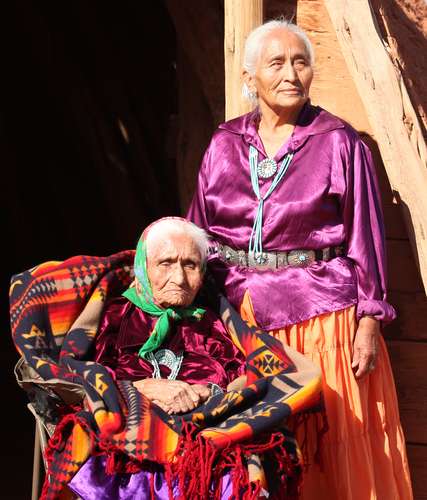The Navajo are an Athapaskan-speaking people whose ancestors arrived in the American Southwest at around A.D. 1400. At contact, their ancestors lived in the four corners region of the American Southwest in an area roughly bounded by Hesperus Peak, Blanca Peak, San Franciso Peak, and Mount Taylor. These four sacred peaks of the Navajo mark their traditional homeland, which they refer to as Dinetah.They were forcibly removed from this homeland in 1863, but allowed to return four years later when the Navajo reservation was established. Initially only 5,000 square miles, it was successively enlarged over the years and today—at more than 27,000 square miles—it is larger than ten states and is the largest Indian reservation in the United States. With more than 300,000 people on its rolls, the Navajo Nation also is the largest tribe in terms of population.
Instructions:Using the slide button on the lower right hand corner, toggle between Dinetah, 1868 Navajo Reservation and Modern Navajo Reservtion pages. You can also click on the tabs on the top of the map to learn more. The selected page is highlighted in blue.
The earliest Spanish accounts indicate that the Navajo and Apache (who are closely related) lived broadly similar lives, with the major difference being the greater emphasis that the Navajo placed on farming. As a result, the Spaniards referred to them as "Apache de Nabajo," using the Tewa word ("Na-ba-ho") for planted fields. The Navajo name for themselves is Diné, which means "The People." In the late 17th and early 18th centuries the Navajo selectively adopted certain aspects of Puebloan and European cultures, and the fusion of these three cultures—Athapaskan, Puebloan, and European—led to the creation of what today is considered traditional Navajo culture.
The most important of the adopted practices included sheep raising and weaving, both of which continue to play major roles in Navajo society.

Required Reading
- Griffin-Pierce Chapter 9
- Video on the Kinaalda (4:28)
Learning Objectives
- Students will be able to trace the origins and development of the Navajo culture, and identify key events and cultural influences that contributed to the form it has taken
- Students will be able to identify major important historic events in Navajo history
- Students will be able to describe Navajo traditional social and political organization, subsistence and economic activities, and major beliefs and ceremonies
- Students will be able to identify major issues facing the Navajo today
- Students will be able to define major terms and concepts relevant to understanding the Navajo culture
Major Concepts and Terms
- Diné
- Athapaskan
- Dinetah
- General James Carlton
- Bosque Redondo
- Kit Carson
- The Long Walk
- Stock reduction program
- Codetalkers
- Outfit
- Changing Woman
- Kinaalda
- Diyen Diné'e
- Hozhó
- Chantway ceremony
- Hand trembler
- Hataali
- Sandpaintings
- Hogan
- Navajo rugs
- Silverworking
- Uranium mining
Optional Resources
For information on Navajo Code Talkers:
- http://navajocodetalkers.org/
- http://www.nmai.si.edu/education/codetalkers/html/chapter4.html
- http://navajopeople.org/navajo-code-talker.htm
Watch the video for information on Navajo uranium mining water contamination
If you have trouble viewing the video, click on this link - https://news.vice.com/video/living-without-water-contamination-nation
Click on next page to continue.
